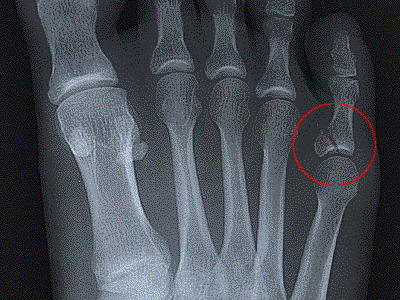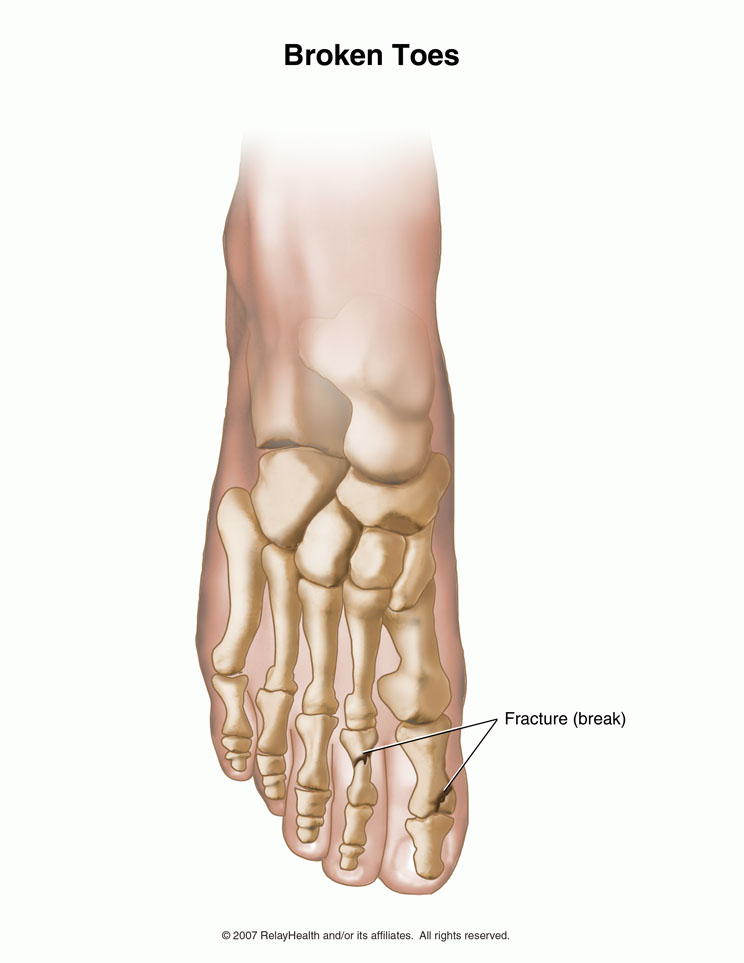Broken Toe Information
Everyone can have a broken toe. Our toes are made of many different bones. One or more of your bones could be fractured usually after an accident or injury of the toes or even the foot.
A fractured toe is often a result of injury or trauma to the toe or the foot. Dropping heavy objects to the toe or stubbing the toe are usually the cause of broken toes.
It may also be a result from long repetitive movements or even stress often occurring in sports. This fracture is called stress fracture meaning that after the injury, swelling, pain, or even stiffness will happen. Walking may be very difficult to walk whenever the big toe is the broken toe due to the strong pain. This injury could lead to other complications such as a broken toenail, ingrown toenail, or even an open fracture.
Broken Toe Symptoms
Picture 1 – X-Ray of a Broken Toe

The main symptom for a broken toe is that the toe will hurt and the patient will feel pain. In addition there are other symptoms to notice: Also,
- The broken toe may be deformed.
- Shoes may be hard to wear and it may feel tight.
- The skin of the toe may look bruised
- The broken toe may look bent.
Certain certain symptoms suggest the broken toe’s condition is more serious. That is when you need to see a doctor or go to the emergency department of a hospital.
- Numbing of the toe and the
- Broken toe is cold.
- The toe may be tingling.
- The broken toe’s skin may have a blue or gray tone.
- Open wounds can appear and may bleed.
- Drainage near the toe may also occur.
These are the symptoms that declare it is time to seek medical help promptly.
If the pain is not relieved or if the pain has worsened, if the broken toe becomes sore, redness appears and there are open wounds, contact a doctor for a proper diagnosis and treatment. Do not ignore this. If the condition has totally worsened, broken toe surgery may be required to prevent further complications
Broken Toe Diagnosis
The diagnosis for a broken toe often consists of a standard medical checkup including a talk with a professional doctor to determine if you do or do not have a broken toe.
The doctor is likely to examine the broken toe and check the foot for any other injuries. The doctor may require the patient to have an x-ray of the toe in order to see if the toe is really broken or not.
However, an x-ray is not always needed in order to diagnose a toe if the injury occurs in the smaller toes and not the large ones. Nonetheless, seeking medical diagnosis is vital for proper treatment and recovery.
Depending on the severity of the broken toe and the conditions surrounding the injury, the patient may need a tetanus shot or treatment with antibiotics to prevent infection. [2]
Broken Toe Treatment
Once your broken toe is diagnosed, there are many treatments you can provide at home. Choose the steps which will decrease swelling and pain. The pain is likely to be bad if swelling occurs after the injury. To reduce the swelling as well as the pain, the foot must be elevated and kept raised above the heart’s level. Placing the foot on top of a few pillows or even reclining can also be a great help.
Ice or cold compacts can help with healing. Simply place some ice in a plastic bag and then place it on the injured or broken toe for fifteen to twenty minutes for every one or two hours during the first and second days. If ice is unavailable, frozen corn or peas can be used as an alternative. To protect the skin, cover the bag of ice or corn or peas with a cloth towel. This will prevent the skin from getting too cold and being damaged during the intermittent applications of the cold pack.
The patient with a broken toe may also use crutches or a special shoe whenever walking. The idea is to prevent putting weight on the broken toe as it heals. There are over-the-counter pain medications which may be taken to ease pain if it is severe. Other medical treatments or therapy can be done in order to make the broken toe healing time faster and easier. Usually a broken toe will heal in about four to six weeks.[3]
If you suspect a broken toe, especially after a known injury, seek help from a doctor. Follow-up with a doctor’s appointment even after recover to be sure there are no additional complications. You want the broken toe to heal correctly and not develop other problems, so protect it during healing and check with the doctor.
Sometimes a broken toe can benefit from being taped to adjacent toes, this is called “buddy taping” and offers extra stability for the injured toe. [2]
Surgery is not often needed for broken toes and if it is performed, it is usually uncomplicated and the recovery is complete. [4]
References:
- http://www.emedicinehealth.com/broken_toe/page1_em.htm
- http://www.medicinenet.com/broken_toe/page5.htm#broken_toe_at-a-glance
- http://www.mayoclinic.com/health/broken-toe/DS01159
- http://orthoinfo.aaos.org/topic.cfm?topic=A00165

